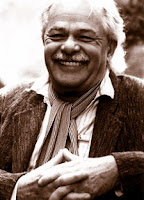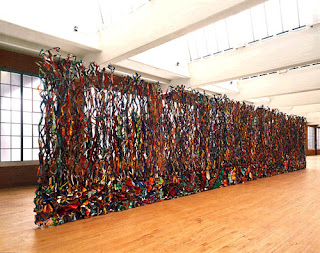Ever since I first took Art History my senior year of high school in 2009, I have admired Robert Rauschenberg. Now, every time I have the option of choosing an artist for a project, paper or in this case, blog, I love taking the time looking into Rauschenberg. Before he died in 2008, he was in the current trend of his time around 1950.
Rauschenberg was an American artist, born in Texas in 1925. He was both a painter and a sculptor, but he also worked with photography, printmaking, papermaking, and performance. He was mostly known for assembling found objects without
any apparent order or meaning. His
famous Combines, combined painting and found objects, declared his
authority as artist to determine what was art, while his lack of
commentary on his own work empowered viewers to decide their own
interpretation. As a side note, I really see my love for found object
art in my own style and media and I gladly put Rauschenberg to blame. He is said to belong to the pop art movement.
Following his parents' wishes, he attended the University of Texas in Austin to study pharmacology, but was expelled
freshman year after refusing to dissect a frog. The draft letter that arrived in 1943 saved him from breaking the news to his
parents. Refusing to kill on the battlefield, he was posted to a hospital caring for combat survivors in San Diego. While on
leave, he saw oil paintings in person for the first time at the East Huntington Library. After the war ended, Rauschenberg
drifted, eventually using the G.I. Bill to pay for art classes at Kansas State University in 1947, and a year later, at the
Academie Julian in Paris. In the late 1940's he attended Black Mountain College in North
Carolina much like many other artists we have gone over in class. All I can say is thank goodness for all those bizarre events or we wouldn't have had him as an artist.
One thing I always found interesting was the fact that he was actually married to another artist named Susan and they even had a son together but then after they divorced, Rauschenberg met the young painter Jasper Johns
in 1954 and after several months of friendship, the two became romantic
and
artistic partners. In 1955, Rauschenberg moved into the same building
as Johns, and the two artist saw each other every day,
exchanging ideas and encouraging their mutual exploration of the
boundaries of art. Though their styles were too different to
form a new movement, the intensity of their artistic partnership has
been compared to the partnership between Georges Braque and
Pablo Picasso. As Rauschenberg said, he and Johns gave each other
"permission to do what we wanted." The pair also grew close to
minimalist composer John Cage and choreographer Merce Cunningham, who
had attended Black Mountain College with Rauschenberg. The
four artists shared a similar philosophy, rejecting the coded psychology
of Abstract Expressionist paintings and embracing the
unplanned beauty in everyday life. Rauschenberg's close relationship
with Johns did not last, however. Johns was featured on the
cover of Art News in 1957 and three of his works were bought by The Modern Museum of Art. This explosion of fame caused tension
between Johns and Rauschenberg, and the they ended their relationship in 1958. Regardless, Rauschenberg remained friend and
collaborator to Cage and Cunningham.
Monday, October 15, 2012
Monday, October 8, 2012
"Mushroom Cloud" - Use of Light
"Mushroom Cloud" by Chris Dury. The hanging sculptural installation is site-specific and can contain
anywhere from 6,000 to 18,000 dried slices of fungi, covered in a layer
of acrylic, mimicking its own form which is consequently also the shape
of a nuclear explosion. I think it is truly beautiful and I love how the use of light compliments the overall piece.
Monday, October 1, 2012
Yves Klein - Post-War European Artist
Yves Klein is considered an important post war European artist. Klein was a pioneer in the development of Performance art, and is seen as an inspiration to and as a forerunner of Minimal art, as well as Pop art. As we watched the video on him in class, I was really interested and inspired by his fire paintings. The fact that some thought to use the way fire burns as an image in art itself was really fascinating. I especially like the second and third piece of his fire paintings that I posted.
Monday, September 24, 2012
Wael Shawky - Documentarist
Wael Shawky's piece, A Glimpse of Clean History - Ceramics, Wood & Velvet comes from his fascination to processes of transition and how an understanding of local systems translates into global relations. The crusades are a prime historical example of a time in transition, of ideological and global expansion. In A Glimpse of Clean History, Shawky introduces his own transformation, albeit with a critical twist: a three-dimensional object in the form of a medieval marionette theater with ceramic dolls. A Glimpse of Clean History transforms the representation of history into a miniaturized theatrical event where the viewers' mode of consumption is mechanically controlled. I admire how he uses art to create and convey his feelings on history and then documents it.
Monday, September 17, 2012
John Cage - Sound in Art
As found on Pbs.org, "In 1952, David Tudor sat down in front of a piano for four minutes and
thirty-three seconds and did nothing. The piece 4′33” written by John
Cage, is possibly the most famous and important piece in twentieth
century avant-garde. 4′33” was a distillation of years of working with
found sound, noise, and alternative instruments. In one short piece,
Cage broke from the history of classical composition and proposed that
the primary act of musical performance was not making music, but
listening." The video of the piece being performed by William Marx can be found here: 4'33" I am not in total favor of this piece per se. I like the idea Cage has of having music being common sounds itself, but I don't like the complete silence. Silence to me, is not music. There has to be something to listen to. But some of his other works are respectable and interesting.
Monday, September 10, 2012
John Chamberlain - Sculptor
Monday, September 3, 2012
Doug Aitken - Cinema
The first image is a photograph taken of Doug Aitken as he worked on Song 1. The second image is a still from the final creation. Wrapping the outside of a circular building in seamless 360-degree video projections took some work. But with Song 1, artist Doug Aitken transforms the drab concrete exterior of the Hirshhorn Museum in Washington, D.C., into a one-of-a-kind audiovisual spectacle. Here is the video itself: Song1 I found that Aitken's video and music choice were seamless. The idea of having projections and beauty on a museum itself is great.
Subscribe to:
Comments (Atom)


















